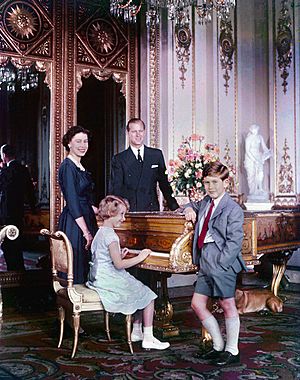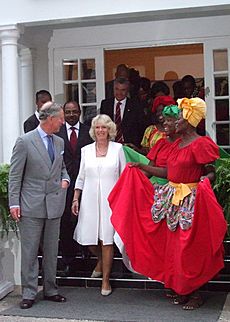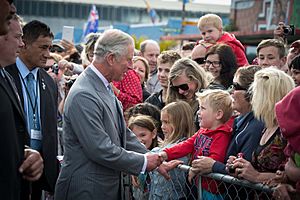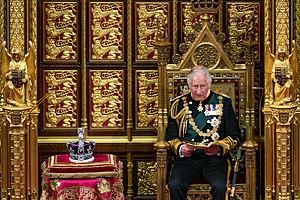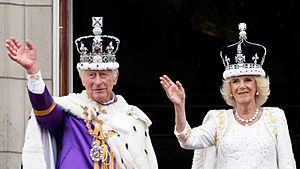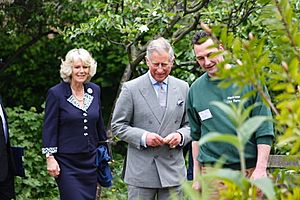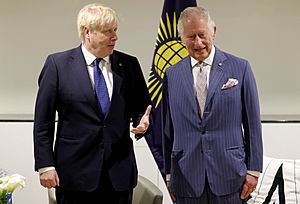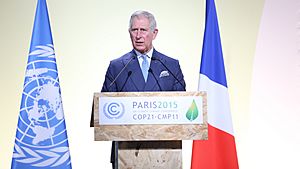Charles III facts for kids
Quick facts for kids Charles III |
|||||
|---|---|---|---|---|---|
| Head of the Commonwealth | |||||

Charles III in 2023
|
|||||
| King of the United Kingdom and the other Commonwealth realms |
|||||
| Reign | 8 September 2022 – present | ||||
| Coronation | 6 May 2023 | ||||
| Predecessor | Elizabeth II | ||||
| Heir apparent | William, Prince of Wales | ||||
| Born | Prince Charles of Edinburgh 14 November 1948 Buckingham Palace, London, England |
||||
| Spouse |
|
||||
| Issue Detail |
|||||
|
|||||
| House | Windsor | ||||
| Father | Prince Philip, Duke of Edinburgh | ||||
| Mother | Elizabeth II | ||||
| Religion | Protestant | ||||
| Education | Gordonstoun School | ||||
| Alma mater | Trinity College, Cambridge (MA) | ||||
| Military career | |||||
| Allegiance | United Kingdom | ||||
| Service/ |
|||||
| Years of active service | 1971–1976 | ||||
| Rank | Full list | ||||
| Commands held | HMS Bronington | ||||
Charles III (born Charles Philip Arthur George on 14 November 1948) is the current King of the United Kingdom. He is also the King of 14 other countries, known as Commonwealth realms. These include places like Australia, Canada, and New Zealand.
Charles became king when his mother, Queen Elizabeth II, passed away in 2022. He was 73 years old, making him the oldest person to become a British monarch. Before becoming king, he was the longest-serving heir apparent (the person next in line to the throne) and Prince of Wales in British history.
He was educated at schools like Gordonstoun and later studied at the University of Cambridge. He also served in the Royal Air Force and the Royal Navy. Charles has two sons, William and Harry, from his first marriage to Lady Diana Spencer. In 2005, he married his long-term partner, Camilla Parker Bowles.
As Prince of Wales, Charles took on many official duties for his mother. He started The Prince's Trust in 1976, which helps young people. He also supported many other charities and causes. He is known for his interest in protecting historic buildings and the environment.
Important events during his reign so far include his coronation in 2023. In 2024, he announced he was receiving treatment for cancer, which caused him to temporarily pause some public events. He has since resumed public duties.
Contents
Early Life and Education
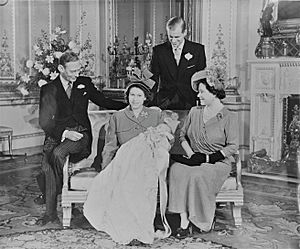
Charles was born at Buckingham Palace in London on 14 November 1948. His parents were Princess Elizabeth (who later became Queen Elizabeth II) and Philip, Duke of Edinburgh. He was their first child. Charles has three younger siblings: Anne, Andrew, and Edward. He was christened Charles Philip Arthur George in December 1948.
When his grandfather, King George VI, died in 1952, Charles's mother became Queen Elizabeth II. This meant Charles immediately became the heir to the throne. He also received several traditional titles, including Duke of Cornwall and Duke of Rothesay. In 1953, he attended his mother's coronation at Westminster Abbey.
Charles was the first heir to the throne to attend school instead of being taught by a private tutor. He went to Hill House School in London, then Cheam School, and later Gordonstoun in Scotland. He also spent time studying in Australia. Charles later said that Gordonstoun taught him a lot about himself.
After school, Charles went to Trinity College, Cambridge, where he studied history. He was the first British heir to earn a university degree, graduating in 1970.
Prince of Wales
Charles was given the title Prince of Wales on 26 July 1958. His official ceremony, called an investiture, took place on 1 July 1969 at Caernarfon Castle. This event was shown on television.
As Prince of Wales, Charles began to take on more public duties. He founded the Prince's Trust in 1976. This charity helps young people across the UK to get jobs, education, and training. He also traveled to many countries, representing the United Kingdom.
Military Service
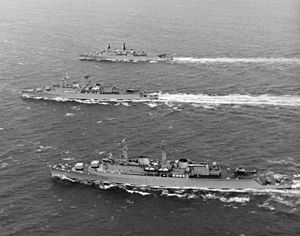
Charles served in the Royal Air Force (RAF) and the Royal Navy in the 1970s. He learned to fly aircraft and earned his RAF wings in 1971. He then joined the Royal Navy, where he served on several ships, including destroyers and frigates.
He also qualified as a helicopter pilot. His last 10 months of active service were spent commanding a coastal minehunter ship, HMS Bronington. He retired from active military service in 1976.
Marriages and Family
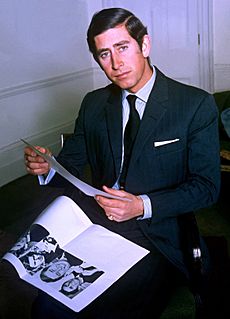
In his younger years, Charles was linked to several women. His great-uncle, Lord Mountbatten, advised him on finding a suitable wife. In 1979, Lord Mountbatten was tragically killed.
Marriage to Lady Diana Spencer
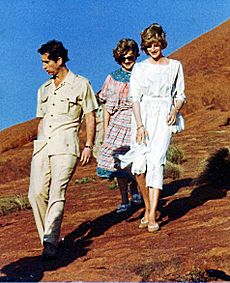
Charles first met Lady Diana Spencer in 1977. They began dating in 1980, and their engagement was announced in February 1981. Their wedding took place at St Paul's Cathedral on 29 July 1981. It was a huge event watched by many people around the world.
Charles and Diana had two sons: William, born in 1982, and Harry, born in 1984. The family lived at Kensington Palace and Highgrove House.
Over time, their marriage faced difficulties, partly due to their different personalities and a nearly 13-year age gap. They legally separated in December 1992 and divorced on 28 August 1996. They shared custody of their children.
Diana tragically died in a car crash in Paris on 31 August 1997. Charles flew to Paris with Diana's sisters to bring her body back to Britain.
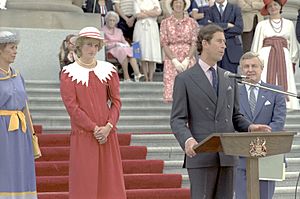
Marriage to Camilla Parker Bowles
Charles and Camilla Parker Bowles made their first public appearance as a couple in 1999. They announced their engagement on 10 February 2005. The Queen gave her consent for the marriage.
Their wedding took place in a civil ceremony at Windsor Guildhall on 9 April 2005. This was followed by a religious blessing at St George's Chapel at Windsor Castle. Charles's parents did not attend the civil ceremony but were present at the blessing and hosted a reception.
Official Duties and Engagements
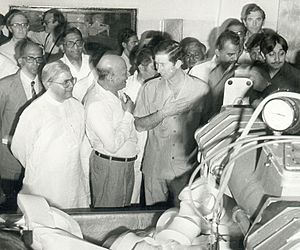
As Prince of Wales, Charles carried out thousands of official duties for the Queen. He attended ceremonies, funerals of important people, and represented the UK on visits abroad. He regularly visited Wales and attended important national events there.
He also represented his mother at independence celebrations in several Commonwealth countries, such as Fiji and Zimbabwe. In 1995, Charles became the first member of the royal family to visit the Republic of Ireland in an official capacity.
In 2018, Commonwealth leaders decided that Charles would become the next Head of the Commonwealth after the Queen. This role is chosen, not inherited. In March 2019, Charles and Camilla made a historic visit to Cuba, the first by British royals.
Charles tested positive for COVID-19 in March 2020 and again in February 2022. In May 2022, he delivered the Queen's Speech to the British Parliament on behalf of his mother.
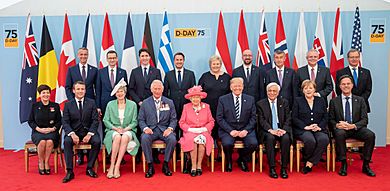
Reign as King
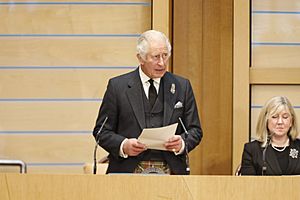
Charles became King on 8 September 2022, following the death of his mother. He gave his first speech to the nation the next day, honoring his mother and announcing that his elder son, William, would become Prince of Wales. On 10 September, the Accession Council publicly announced Charles as King in a ceremony televised for the first time.
His coronation with Camilla took place at Westminster Abbey on 6 May 2023. It was a traditional Church of England ceremony. In July 2023, the royal couple attended a service in Scotland where Charles was presented with the Honours of Scotland.
In November 2022, the King and Queen hosted the President of South Africa, Cyril Ramaphosa, for the first state visit of Charles's reign. In March 2023, Charles became the first British monarch to address the German Parliament. In September 2023, he also became the first British monarch to speak from the French Senate chamber during a state visit.
In October 2024, the King and Queen toured Australia and Samoa. Australia was the first Commonwealth realm Charles visited as King. In Samoa, he attended the Commonwealth Heads of Government Meeting for the first time as Head of the Commonwealth.
Health
Charles has had several medical procedures over the years. In March 1998, he had knee surgery. In March 2003, he had surgery for a hernia. A non-cancerous growth was removed from his nose in 2008.
In January 2024, he had a procedure for a benign prostate enlargement. In February, Buckingham Palace announced that cancer had been found during this treatment, though it was not prostate cancer. He continued to perform his constitutional duties while receiving outpatient treatment. He expressed his support for cancer charities and remained positive about his recovery.
In March 2025, Charles was briefly admitted to hospital for temporary side effects from his cancer treatment. He postponed some planned engagements.
Diet and Lifestyle
Charles has shown interest in healthy eating. As early as 1985, he spoke about eating less meat and more fish. In 2021, he shared that he eats no meat or fish two days a week, and no dairy products one day a week. He typically eats fruit salad, seeds, and tea for breakfast, skips lunch, and has dinner around 8:30 pm.
He has also confirmed that foie gras is not served at any royal residences. He stopped its use at his own properties more than a decade before becoming king.
Charity Work
Charles has been very active in charity work. He founded the Prince's Trust in 1976, using money he received from the Royal Navy. He has since started 16 more charitable organizations. These groups, known as the Prince's Charities, work on many issues like education, helping young people, protecting the environment, and supporting businesses.
The King Charles III Charitable Fund has given over £73 million to various causes since 1979. By September 2020, the Prince's Trust had helped over 1,000,000 young people. Charles has also been a patron or president of more than 800 other charities.
He has supported humanitarian projects, including a charity for Romanian orphans. He also made a private donation to the Peres Center for Peace and Innovation in Israel.
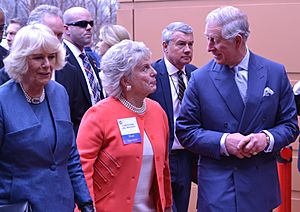
Personal Interests
Charles has always encouraged understanding and respecting Indigenous peoples. He believes they have important messages about protecting the land and resolving conflicts. He connects this view with his efforts against climate change.
In 2015, letters Charles sent to British government ministers were released. These letters, known as the "black spider memos" because of his handwriting, showed his concerns about various policy issues. The public reaction was mostly supportive of Charles.
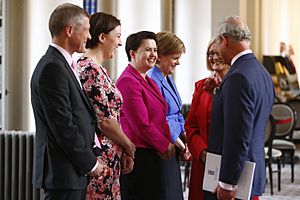
Architecture and Urban Planning
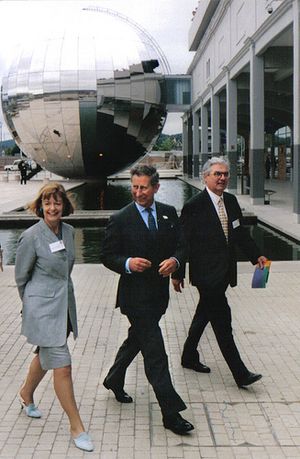
Charles has strong opinions on architecture and how towns are built. He believes in traditional designs and methods. In 1984, he famously described a proposed extension to the National Gallery in London as a "monstrous carbuncle."
He has campaigned for traditional urban planning, restoring historic buildings, and sustainable design. The village of Poundbury in Dorset was built on land owned by the Duchy of Cornwall following Charles's ideas. He also helped save Dumfries House in Scotland, turning it into a museum and training center.
In 2005, Charles received the Vincent Scully Prize for his work in architecture. He donated the prize money to help communities damaged by Hurricane Katrina.
Natural Environment
Charles has been a strong supporter of environmental protection since the 1970s. He gave his first speech on environmental issues when he was 21. He is also a keen gardener and has emphasized the importance of connecting with nature.
He developed an interest in organic farming at his Highgrove estate. In 1990, he launched his own organic food brand, Duchy Originals. The profits from these products are donated to his charities. Charles has also spoken against genetically modified crops.
He launched the Sustainable Markets Initiative in 2020, which encourages putting sustainability at the center of all activities. He has spoken at major climate conferences like COP26 and COP28, urging global action to prevent climate change.
Health and Well-being
Charles has shown interest in different approaches to health and well-being, including homeopathy. He believes in a balanced approach to health. His charity, the College of Medicine, promotes integrated health.
Sports
Charles was an enthusiastic polo player until 2005. He also participated in fox hunting until it was banned in the UK. He has had several injuries from these sports over the years.
He is a keen salmon angler and supports efforts to protect the North Atlantic salmon. He often fishes in the River Dee in Scotland. Charles is also a supporter of Burnley F.C., a football club.
Arts and Culture
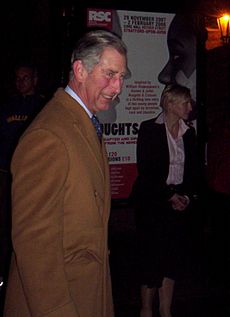
Charles is involved with many performing arts organizations as a president or patron. These include the Royal College of Music and the Royal Shakespeare Company. In 2000, he brought back the tradition of appointing an Official Harpist to the Prince of Wales to support Welsh musical talent.
He is also a talented watercolour artist. He has published books of his paintings and exhibited his work to raise money for charity. In 2000, he founded the Royal Drawing School, which offers drawing classes to the public. His paintings have been displayed in London and Australia.
Charles has written several books and contributed to many others. He has also appeared in documentary films.
Religion and Beliefs
Charles is a committed Anglican Christian. As King, he is the Supreme Governor of the Church of England. He also attends the Church of Scotland.
He has a broad interest in philosophy and other religions. He has visited Eastern Orthodox monasteries and met with leaders from different faiths. He sees his role as King as protecting the diversity of the country, including allowing people of all faiths and beliefs to practice freely.
Residences and Finances
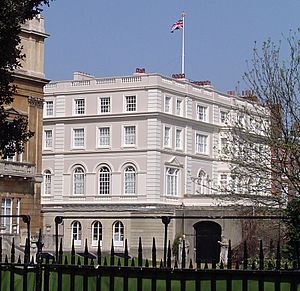
Charles's official London home since 2003 has been Clarence House. He previously lived at Kensington Palace. He also rents Highgrove House in Gloucestershire, which is owned by the Duchy of Cornwall. He also owns a property in Romania.
As Prince of Wales, his main income came from the Duchy of Cornwall, which owns a large amount of land and properties. He has voluntarily paid tax on this income since 1993.
Titles and Symbols
[[Multiple image | total_width = 250 | image1 = Royal_Cypher_of_King_Charles_III.svg | alt1 = A logo with "CR III" and a crown (coloured) | caption1 = Royal cypher of Charles III, surmounted by the Tudor Crown | image2 = Royal Cypher of King Charles III (Scotland).svg | alt2 = A logo with "CR III" and a crown | caption2 = Scottish royal cypher of Charles III, surmounted by the Crown of Scotland | image3 = Royal Cypher of King Charles III (Canada).svg | alt3 = A logo with "CR III" and a crown | caption3 = Canadian royal cypher of Charles III, surmounted by the Canadian Royal Crown ]] Charles holds many titles and honorary military positions across the Commonwealth. In each of his realms, he has a distinct title, such as King of Australia and His other Realms and Territories. He is also known as Defender of the Faith.
When he became King, he chose the regnal name Charles III. He could have chosen another of his given names, but he decided to continue the name Charles.
In 2012, his mother awarded him the highest rank in all three armed services: Admiral of the Fleet (Navy), Field Marshal (Army), and Marshal of the Royal Air Force.
Coats of Arms
[[multiple image | align = center | total_width = 700 | perrow = | image1 = Coat of arms of the Prince of Wales.svg | caption1 = Coat of arms as Prince of Wales (1958–2022) | image2 = Royal Coat of Arms of the United Kingdom (Tudor crown).svg | caption2 = Royal coat of arms of the United Kingdom | image3 = Coat of arms of the United Kingdom in Scotland.svg | caption3 = Royal coat of arms of the United Kingdom for use in Scotland | image4 = Royal Coat of Arms of Canada.svg | caption4 = Royal coat of arms of Canada | footer = ]] As Prince of Wales, Charles had a special coat of arms based on the UK's royal arms. It included a small shield for the Principality of Wales and the motto Ich dien (German for "I serve").
When he became King, he inherited the royal coats of arms of the United Kingdom and Canada. His royal cypher, which is his personal symbol, features the letters "CR III" and the Tudor Crown.
Royal Standards
[[Multiple image |perrow =4 |total_width =700 |align =center |header =Royal Standards |caption_align =center |image1 =Royal Standard of the United Kingdom.svg |caption1 =United Kingdom (outside Scotland) |image2 =Royal Standard of the United Kingdom (in Scotland).svg |caption2 =Scotland |image3 =Royal Standard of Canada.svg |caption3 =Canada |image4 =Royal Standard of Australia.svg |caption4 =Australia ]] The royal standard is a special flag used to represent the King. The design varies depending on the location. For the United Kingdom, it is the Royal Standard of the United Kingdom, which has been used by British monarchs for centuries. Canada and Australia also have their own royal standards for the King.
Issue
| Name | Birth | Marriage | Children | |
|---|---|---|---|---|
| Date | Spouse | |||
| William, Prince of Wales | 21 June 1982 | 29 April 2011 | Catherine Middleton | |
| Prince Harry, Duke of Sussex | 15 September 1984 | 19 May 2018 | Meghan Markle | |
Published Works
King Charles III has written or co-authored several books:
- The Old Man of Lochnagar. 1980.
- A Vision of Britain: A Personal View of Architecture. 1989.
- Rain Forest Lecture. 1990.
- HRH the Prince of Wales Watercolours. 1991.
Interesting Facts About Charles III
- Charles is a talented watercolourist. He has published books about his art and sold some of his paintings to raise money for charity.
- He is a supporter of Burnley F.C., a football club.
- His own organic food brand, Duchy Originals, sells over 200 different products. The profits from these sales go to his charities.
- Charles does not like chocolate, coffee, or garlic.
- In 2022, it was reported that he eats a breakfast of fruit salad, seeds, and tea. He doesn't eat lunch, but has tea at 5:00 p.m. and dinner at 8:30 p.m., often working until midnight.
- The holy oil used for Charles's coronation was vegan.
- Instead of Charles III, the King could have chosen to reign as George VII or used one of his other given names.
See also
 In Spanish: Carlos III del Reino Unido para niños
In Spanish: Carlos III del Reino Unido para niños


